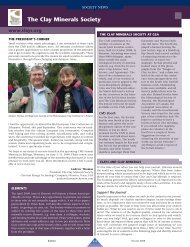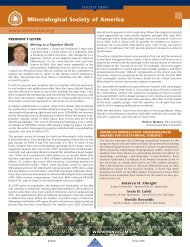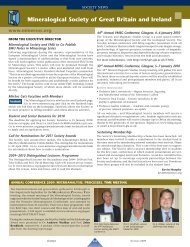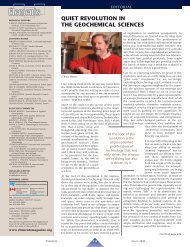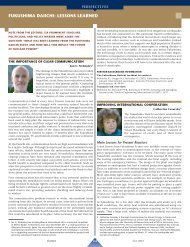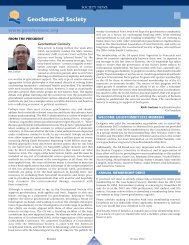Mineralogical Society of Great Britain and Ireland - Elements ...
Mineralogical Society of Great Britain and Ireland - Elements ...
Mineralogical Society of Great Britain and Ireland - Elements ...
- No tags were found...
You also want an ePaper? Increase the reach of your titles
YUMPU automatically turns print PDFs into web optimized ePapers that Google loves.
SOCIETY NEWSwww.minersoc.org<strong>Mineralogical</strong> <strong>Society</strong> <strong>of</strong><strong>Great</strong> <strong>Britain</strong> <strong>and</strong> Irel<strong>and</strong>FROM THE PRESIDENTA colleague recently referred with approval to a ‘wind <strong>of</strong>change’ at the <strong>Mineralogical</strong> <strong>Society</strong> <strong>of</strong> <strong>Great</strong> <strong>Britain</strong> <strong>and</strong>Irel<strong>and</strong>, <strong>and</strong> it has been exciting for me to have beenPresident when the <strong>Society</strong> was eager for some change.When I commenced <strong>of</strong>fice there was a general realizationthat the <strong>Society</strong> was not increasing its membership<strong>and</strong> maintaining involvement with its members, <strong>and</strong> asmall group called the Strategy Committee met to discuss these <strong>and</strong>other matters. This group made a number <strong>of</strong> straightforward proposalswhich, with the strong support <strong>of</strong> MinSoc Council, we have put intoeffect in the last 18 months.With the greatest pleasure, at leastfor the moment, we have witnessedthe enrolment <strong>of</strong> nearly 150 newstudent members in 2007. I say‘for the moment’ because thissuccess is undoubtedly due to us<strong>of</strong>fering something for nothing,namely free membership;nonetheless it remains a greatpleasure to discover the interest<strong>of</strong> young people in our science.We hope that this involvement inthe <strong>Society</strong> will continue <strong>and</strong>grow, <strong>and</strong> we encourage this by<strong>of</strong>fering continuing studentmembership for only £10.I think one <strong>of</strong> the inherentstrengths <strong>of</strong> the MinSoc is thegreat breadth <strong>of</strong> its interests inmineralogy, petrology <strong>and</strong>geochemistry. These are pursuedthrough seven special interestgroups (SIGs), covering studies atthe extremes <strong>of</strong> pressure <strong>and</strong>temperature as well as in theenvironmental <strong>and</strong> applied aspects<strong>of</strong> our science. Each <strong>of</strong> these groupsprovides a special communitywhere people may hold formal<strong>and</strong> informal meetings, includinglab-based <strong>and</strong> field-basedworkshops. At the same time, theSIG substructure leaves the parentsociety free to follow a moreinternational programme. This waswell demonstrated by the verysuccessful Frontiers in MineralSciences meeting, organized bythe MinSoc <strong>and</strong> held in Cambridgein June as a joint meeting <strong>of</strong> theAmerican, Canadian, French <strong>and</strong>British-Irish mineralogical societies.Another pleasure in the last 18months has been seeing theeagerness with which existingmembers are prepared to supportthe <strong>Society</strong> in its endeavours. Thishas been well shown in the creation<strong>of</strong> an Awards Committee <strong>and</strong> there-introduction <strong>of</strong> a DistinguishedLecturer programme. Over the pasttwo years, ten experienced membersoutside Council have readilyagreed to form part <strong>of</strong> a committeeassessing the nominations for the<strong>Society</strong>’s Schlumberger <strong>and</strong> MaxHey Awards. Two DistinguishedLecturers, Jon Blundy <strong>and</strong> DavidVaughan, are currently giving aschedule <strong>of</strong> presentations across thel<strong>and</strong>, from Galway to East Anglia<strong>and</strong> Glasgow to Brighton (seeopposite page for further details).Support for <strong>Mineralogical</strong> Magazine<strong>and</strong> Clay Minerals has come fromscientists being prepared to widenthe board <strong>of</strong> associate editors. Anew production editor has alsobeen appointed. However, we dohave to be wary that our journals,like those <strong>of</strong> other not-so-largelearned societies, do not sufferfrom the current preoccupationwith impact factors. We mustencourage members to submitpapers to <strong>Society</strong> journals – I amputting a memo to this effect onmy own desk!Last, I wish to express the <strong>Society</strong>’sthanks to Adrian Lloyd-Lawrence,our recently retired ExecutiveSecretary, who promoted theactivities <strong>and</strong> oversaw the affairsSOCIETY MEDALLISTS FOR 2008<strong>of</strong> the <strong>Society</strong> for eight years. Adinner to pay tribute to Adrian’scontributions was held inNovember. In his place we welcomeKevin Murphy. With Kevin asExecutive Director <strong>and</strong> MichaelCarpenter as incoming President,I am sure the <strong>Mineralogical</strong> <strong>Society</strong>is in good h<strong>and</strong>s.Ben HartePresidentWe are delighted to announce that the <strong>Society</strong>’s medal winners for2008 have been selected, with the assistance <strong>of</strong> the newly appointedAwards Committee, chaired by Michael Carpenter.The Schlumberger Award winner for 2008 isPr<strong>of</strong>. David Rubie <strong>of</strong> Bayerisches Geoinstitut.Pr<strong>of</strong>. Rubie started his career studying high-pressuremetamorphic rocks, when he became fascinatedby the processes <strong>and</strong> conditions <strong>of</strong> mineraltransformations. In order to extend <strong>and</strong> advancehis ideas into the deeper interior <strong>of</strong> the Earth, hewas led into high-pressure experimental sciences,<strong>and</strong> he has remained at the forefront <strong>of</strong> researchin that field for the past 20 years. To further hisDavid Rubieinvestigations, he built the first European multianvillaboratory at the Bayerisches Geoinstitut,which enabled him to diversify his interests into most aspects <strong>of</strong> mantlephysics <strong>and</strong> chemistry, such as reaction kinetics, transport properties,phase transformations <strong>and</strong> element partitioning. In addition,through his conscientious efforts in funding this laboratory as aEuropean User Facility, he helped high-pressure research to blossom<strong>and</strong> exp<strong>and</strong> in Europe, not only in many aspects <strong>of</strong> Earth science, butalso in materials science, physics <strong>and</strong> chemistry.The Max Hey Medal winner for 2008 is DrDiego Gatta <strong>of</strong> the University <strong>of</strong> Milan. Dr Gattais well known for his high-pressure studies <strong>of</strong>natural zeolites. Despite the fact that zeolites arefound in low-pressure metamorphic rocks (zeolitefacies), the value <strong>of</strong> high-pressure studies <strong>of</strong>zeolites is that they allow the recognition <strong>of</strong> significantcorrelations between framework topology<strong>and</strong> physical behaviour, extending earlierwork on feldspars <strong>and</strong> analcime. Three thematicDiego Gattapapers by Dr Gatta on the structural behaviour<strong>of</strong> edingtonite illustrate his skill in making subtleyet significant insights into mineral behaviour. His work on zeoliteshas had a significant impact on research directions in this field <strong>and</strong>impinges on industrial applications <strong>of</strong> zeolite/microporous materialstechnology.The medals will be presented at the conference dinner <strong>of</strong> the <strong>Society</strong>’s2008 annual meeting, ‘Geochemistry <strong>of</strong> the Earth’s Surface 8’, to beheld in London in August 2008.CLAY MINERALS GROUP MEETINGALUMINIUM AND SILICON IN SOILS AND THE ENVIRONMENTThe meeting is being held to commemorate the life <strong>and</strong> work <strong>of</strong> V. C. Farmerwho during his career at the Macaulay Institute made major contributionsto our underst<strong>and</strong>ing <strong>of</strong> the mineralogy <strong>and</strong> chemistry <strong>of</strong> aluminium <strong>and</strong>silicon in soils, as well as pioneering the use <strong>of</strong> infrared spectroscopy in theidentification, characterization <strong>and</strong> reactivity <strong>of</strong> the amorphous or poorlycrystalline secondary minerals involved. The latest developments in theseissues will be addressed by a number <strong>of</strong> eminent keynote speakers. Moredetails from www.minersoc.org/pages/groups/cmg/cmg.html <strong>and</strong> inforthcoming issues <strong>of</strong> <strong>Elements</strong>.E LEMENTS 424DECEMBER 2007
SOCIETY NEWSSOCIETY BURSARY REPORTSThe <strong>Society</strong> <strong>of</strong>fers £6000 per annum in student <strong>and</strong> senior bursaries to beused for field work, travel to conferences, etc. Below are extracts fromreports received from three recent awardees. Their full reports are availableat the <strong>Society</strong>’s website www.minersoc.org/pages/awards/bursary.html.Ping LuoPing Luo <strong>of</strong> Nottingham University (UK)attended the 3 rd International Conference onEnvironmental Science <strong>and</strong> Technology 2007,which was organized by the American Academy<strong>of</strong> Sciences. This four-day conference was packedwith 15 major platform sessions, two poster sessions<strong>and</strong> four registration exhibitions. Ping’stalk on permeable reactive barriers was wellreceived, <strong>and</strong> she has forged links with colleaguesin a number <strong>of</strong> other institutes as a result<strong>of</strong> attending the meeting.In June 2007, Robert M. Hough (CSIRO) travelledto Europe from Australia for the Frontiers inMineral Sciences meeting in Cambridge, UK,<strong>and</strong> the International Applied GeochemistrySymposium in Oviedo, Spain. The bursary contributedtowards his flight from Australia <strong>and</strong>provided assistance for his attendance at bothmeetings. He gave two oral presentations at each<strong>of</strong> these meetings <strong>and</strong>, in addition, two posterpresentations at the Frontiers meeting. The talksRobert Hough<strong>and</strong> posters were based on detailed studies <strong>of</strong>gold, both primary <strong>and</strong> secondary. In particular,he detailed a new occurrence <strong>of</strong> colloidal, nanoparticulate gold, attractingwidespread attention <strong>and</strong> acclaim at both meetings. While in theUK, Robert also visited London, where he gave an invited talk at theEarth Sciences Department <strong>of</strong> Imperial College on new developments ingold research in Australia.Victoria VryVictoria Vry (Imperial College, London) used her bursary to attend theSGA (<strong>Society</strong> for Geology Applied to Mineral Deposits) meeting inDublin where she presented her poster ‘Microanalysis <strong>of</strong> Ore-FormingFluids at El Teniente, Chile’. Victoria welcomed the opportunity to meetwith many industry representatives present at the meeting.ADMINISTRATIVE MATTERSAt the end <strong>of</strong> 2007, Ben Harte (President), Neil Fortey (Treasurer), AndyRankin (Custodian Trustee), <strong>and</strong> Andrew Kerr <strong>and</strong> Jim MacDonald(Council members) will complete their terms <strong>of</strong> <strong>of</strong>fice (which varyfrom two to six years in length). We are hugely indebted to them allfor the time <strong>and</strong> energy they put into the <strong>Society</strong>. Progress in the manyfacets <strong>of</strong> the <strong>Society</strong>’s activities would not be possible without theefforts <strong>of</strong> these people.Michael Carpenter (President), Chris Stanley (Treasurer), Adrian Jones(Council), Norman Moles (Council), <strong>and</strong> Tony Law (Council) will fillthe vacancies from the beginning <strong>of</strong> 2008, though some have alreadybecome involved in the workings <strong>of</strong> the <strong>Society</strong>.In September 2007, two new staff members joined the <strong>Society</strong>. We welcomeMartin Hughes (Administrative Assistant, admin@minersoc.org)<strong>and</strong> David Mole (Production Editor, david@minersoc.org), who joinRussell Rajendra (Finance Manager, russell@minersoc.org) <strong>and</strong> KevinMurphy (Executive Director, kevin@minersoc.org).GEOCHEMISTRY OF THE EARTH’S SURFACE 8 (GES8)Updated information on this meeting is provided elsewhere in thisissue <strong>of</strong> <strong>Elements</strong> (see ad on page 427) <strong>and</strong> also at the conference website(www.ges8.com) where online registration will be available beginningon 1 January 2008.MINERALOGICAL SOCIETYDISTINGUISHED LECTURER PROGRAMMEThe 2007/2008 DistinguishedLecturer programme is wellunderway. Pr<strong>of</strong>essor DavidVaughan <strong>of</strong> the University <strong>of</strong>Manchester completed his tour<strong>of</strong> four UK <strong>and</strong> Irish universities(Brighton, Cambridge, Liverpool<strong>and</strong> Galway) in November, wherehe delivered a lecture entitled‘Minerals, Metals, Molecules <strong>and</strong>Microbes: EnvironmentalMineralogy <strong>and</strong> Sustainability’.Pr<strong>of</strong>. Jon Blundy will commence hisprogramme early in the New Yearwith a lecture entitled ‘TheSubterranean Machinations <strong>of</strong>Explosive Volcanoes’. His scheduleis as follows:7 January 2008University College Dublin4 February 2008University <strong>of</strong> East Anglia13 March 2008Lancaster University14 March 2008Glasgow UniversityFull details are available atthe <strong>Society</strong>’s website:www.minersoc.org/pages/announce/announce.htmlE LEMENTS 425DECEMBER 2007




